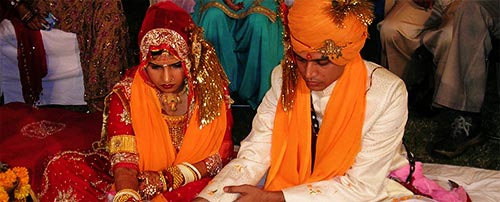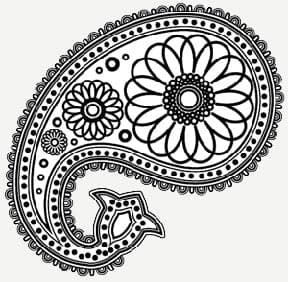Sacred Hindu texts exist that describe rites, rituals, and traditions estimated to date back to 3000 B.C. The Hindu wedding is one of the most sacred of those rites, a sacrament (Sanskara) that incorporates many of the rituals and customs. Years ago, the weddings would take several days following local customs. However now it is hard to commit to so many days in modern society. Most are now held the night before and the day of the ceremony itself.
There are events that may happen a long time before the wedding to welcome the bride and groom, and introduce the two families. Depending where family ancestors have come from, these traditions may vary. A ceremony called Mangni is held to bless the bride and groom to be by presenting them with gifts.
The actual Hindu wedding ceremony is based on the marriage of Surya, the daughter of Savita (The Sun) to Ashwinikumar, as described in the Rig-Veda, one of the oldest Hindu scriptures. The steps in the actual wedding ceremony may vary in different Hindu sects, the steps in the traditional Vedic wedding ceremony follow this pattern:
Hindu Wedding Ceremony
Vara Satkaarah – Reception of the bridegroom and his kinsmen at the entrance gate of the wedding hall where the officiating priest chants a few mantras and the bride’s mother blesses the groom with rice and trefoil and applies tilak of vermilion and turmeric powder.
Madhuparka Ceremony – Reception of the bridegroom at the altar and bestowing of presents by the bride’s father.
Kanya Dan – The bride’s father gives away his daughter to the groom amidst the chanting of sacred mantras.
Vivah-Homa – The sacred fire ceremony ascertaining that all auspicious undertakings are begun in an atmosphere of purity and spirituality.
Pani-Grahan – The groom takes the right hand of the bride in his left hand and accepts her as his lawfully wedded wife.
Pratigna-Karan – The couple walk round the fire, the bride leading, and take solemn vows of loyalty, steadfast love and life-long fidelity to each other.
Shila Arohan – The mother of the bride assists her to step onto a stone slab and counsels her to prepare herself for a new life
Laja-Homah – Puffed rice offered as oblations into the sacred fire by the bride while keeping the palms of her hands over those of the groom.
Parikrama or Pradakshina or Mangal Fera – The couple circles the sacred fire seven times. This aspect of the ceremony legalizes the marriage according to the Hindu Marriage Act as well custom.
Saptapadi – Marriage knot symbolized by tying one end of the groom’s scarf with the bride’s dress. Then they take seven steps representing nourishment, strength, prosperity, happiness, progeny, long life and harmony and understanding, respectively.
Abhishek – Sprinkling of water, meditating on the sun and the pole star.
Anna Praashan – The couple make food offerings into the fire then feed a morsel of food to each other expressing mutual love and affection.
Aashirvadah – Benediction by the elders.
(List created by By Subhamoy Das Hinduism Expert)
The descriptions above cannot begin to describe the art, the beauty, and the décor of the Hindu wedding. This video that lasts for a little more than 5 minutes is just one example of how it may look. If you wish to see more, there are several other videos on the same page that have more detail, and occur in different places.
If you would like to use San Diego Boat Tours for your Hindu wedding, be sure to give us a call. Many weddings are held on the boat tours of many different denominations.


